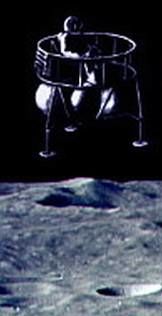
Home - Search - Browse - Alphabetic Index: 0- 1- 2- 3- 4- 5- 6- 7- 8- 9
A- B- C- D- E- F- G- H- I- J- K- L- M- N- O- P- Q- R- S- T- U- V- W- X- Y- Z
LM Langley Lightest
 LM Langley Lightest |
Status: Study 1961. Payload: 100 kg (220 lb). Gross mass: 1,460 kg (3,210 lb). Unfuelled mass: 460 kg (1,010 lb). Specific impulse: 433 s. Height: 2.90 m (9.50 ft).
This version used cryogenic propellants to get a single crewman from lunar orbit, to the lunar surface, and back, at an all up mass of only 1,460 kg.
Earliest lunar orbit rendezvous schemes involved use of one or more extremely lightweight, unpressurized lunar landers to each take a single astronaut to the lunar surface. This Langley design was the absolute minimum considered. Others ranged from 3,284 kg to 4,372 kg - to be compared with the 15,000 kg design that eventually was selected.
Crew Size: 1.
Family: Lunar Landers, Moon. Country: USA. Propellants: Lox/LH2. Agency: NASA Langley. Bibliography: 26, 27.
 | Langley Lunar Lander Credit: © Mark Wade |
Back to top of page
Home - Search - Browse - Alphabetic Index: 0- 1- 2- 3- 4- 5- 6- 7- 8- 9
A- B- C- D- E- F- G- H- I- J- K- L- M- N- O- P- Q- R- S- T- U- V- W- X- Y- Z
© 1997-2019 Mark Wade - Contact
© / Conditions for Use